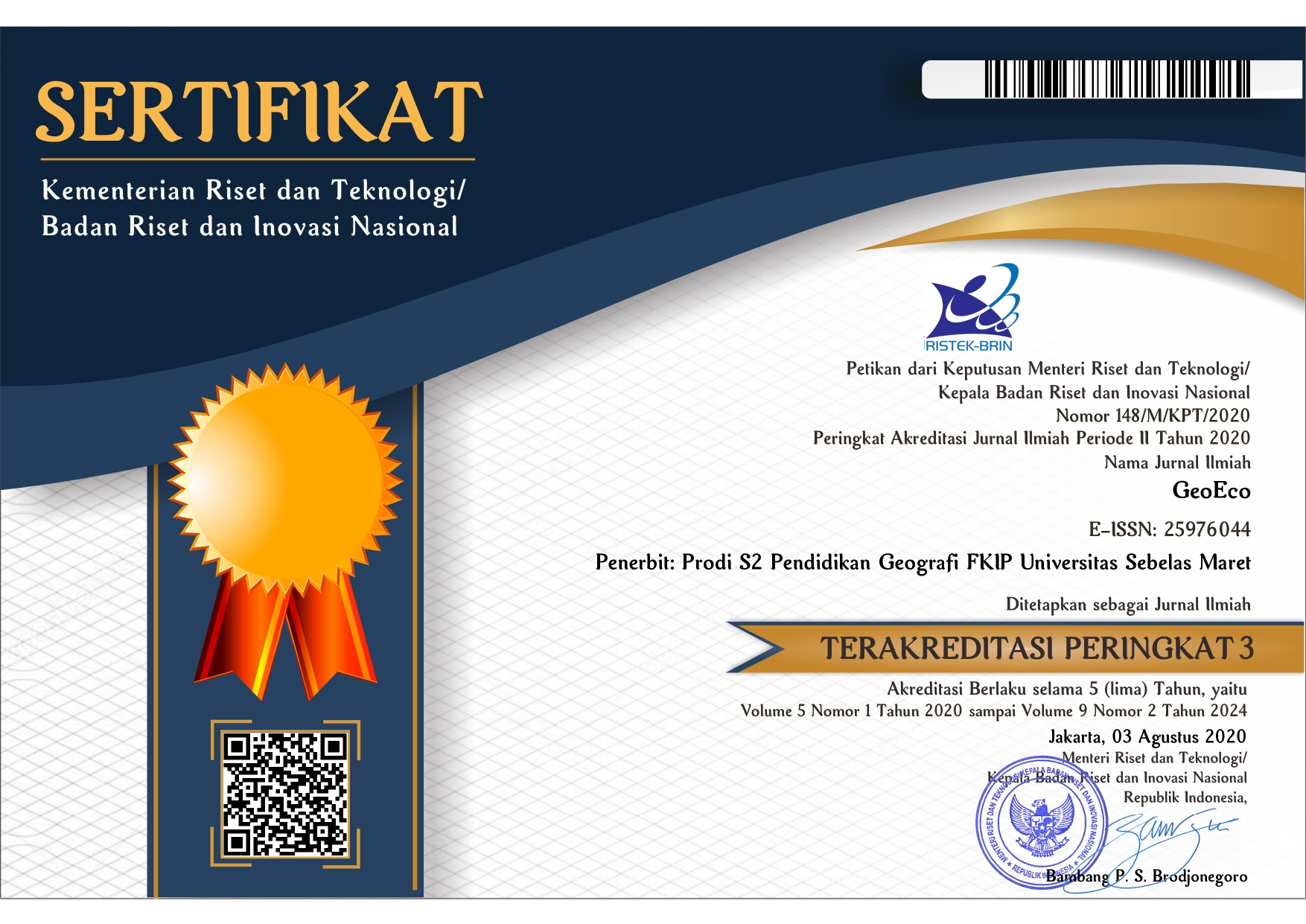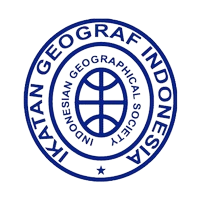DISTRIBUTION OF URBAN HEAT ISLAND INDEX IN THE SURABAYA, YOGYAKARTA, AND BANDUNG USING REMOTE SENSING
Abstract
Keywords
Full Text:
PDFReferences
Abulibdeh, A. (2021). Analysis of Urban Heat Island Characteristics and Mitigation Strategies for Eight Arid and Semi-Arid Gulf Region Cities. Environmental Earth Sciences, 80, 1-26.
Abuwaer, N., Ullah, S., & Al‐Ghamdi, S. G. (2023). Building Climate Resilience Through Urban Planning: Strategies, Challenges, and Opportunities. Sustainable Cities in a Changing Climate: Enhancing Urban Resilience, 185-206. DOI: https://doi.org/10.1002/9781394201532.ch12
Afriyanie, D., Julian, M. M., Riqqi, A., Akbar, R., Suroso, D. S., & Kustiwan, I. (2020). Re-framing urban green spaces planning for flood protection through socio-ecological resilience in Bandung City, Indonesia. Cities, 101, 102710. DOI: https://doi.org/10.1016/j.cities.2020.102710
Aini, A. N., Rapang, S. K., Bayanuddin, A. A. (2021). Utilization of Morning and Evening Sentinel-3 SLSTR Imagery Data for Analysis of Surface Heat Island Phenomenon Intensity (case study of Bandung City). Jurnal Penginderaan Jauh dan Pengolahan Data Citra, 18, 1.
Amalia, S. (2011). Desain Interior Sekolah Dasar Internasional Berwawasan Lingkungan. Thesis: Universitas Sebelas Maret.
Anjani, S. J., & Puspaningtyas, A. (2024). Dampak Kondisi Lingkungan Pesisir Terhadap Sosial Ekonomi Penduduk Kenjeran Surabaya. Eksekusi: Jurnal Ilmu Hukum dan Administrasi Negara, 2(1), 01-14.
Ar'afii, E. A., Sugianto, S., Wijaya, L., Rusdi, M., Basri, H. (2024). The Examination of the Relationship Between Land Cover and Land Surface Temperature in Karang Baru Sub-District, Aceh Province, Indonesia. In IOP Conference Series: Earth and Environmental Science, 1356, 1, 012048. https://doi.org/10.1088/1755-1315/1356/1/012048
Arifwidodo, S., Chandrasiri, O., Abdulharis, R., Kubota, T. (2019). Exploring the Effects of Urban Heat Island: a Case Study of Two Cities in Thailand and Indonesia. APN Science Bulletin, 9, 1. http://doi.org/10.30852/sb.2019.539
Bibri, S. E., Krogstie, J., & Kärrholm, M. (2020). Compact City Planning and Development: Emerging Practices and Strategies for Achieving the Goals of Sustainability. Developments in the Built Environment, 4, 100021.
BPS. (2020). Kota dalam Angka 2020.
Carrillo, G. A., Andrade, J. L., Valdez-Lazalde, J. R., Reyes-García, C., & Hernández-Stefanoni, J. L. (2022). Characterizing Spatial and Temporal Deforestation and Its Effects on Surface Urban Heat Islands in a Tropical City Using Landsat Time Series. Landscape and Urban Planning, 217, 104280.
Dickinson, D. C., & Ramalho, C. E. (2022). A Balancing Act: Biodiversity and Human Wellbeing Considerations in the Management of Urban Forest in a Global Biodiversity Hotspot. Urban Forestry & Urban Greening, 74, 127656.
Diener, A., & Mudu, P. (2021). How Can Vegetation Protect Us From Air Pollution? A Critical Review on Green Spaces' Mitigation Abilities for Air-Borne Particles From A Public Health Perspective-With Implications for Urban Planning. Science of the Total Environment, 796, 148605.
Fan, L., Wang, J., Han, D., Gao, J., & Yao, Y. (2022). Research on Promoting Carbon Sequestration of Urban Green Space Distribution Characteristics and Planting Design Models in Xi’an. Sustainability, 15(1), 572.
Feldman, A. F., Short Gianotti, D. J., Dong, J., Trigo, I. F., Salvucci, G. D., & Entekhabi, D. (2023). Tropical Surface Temperature Response to Vegetation Cover Changes and the Role of Drylands. Global Change Biology, 29(1), 110-125.
Firozjaei, M. (2020). Modeling Surface Heat Island Intensity According to Differences of Biophysical Characteristics: A Case Study of Amol City, Iran. Ecological Indicators, 109. DOI: https://doi.org/10.1016/j.ecolind.2019.105816
Guha, S., Govil, H., Gill, N., & Dey, A. (2021). A Long-Term Seasonal Analysis on the Relationship Between LST and NDBI Using Landsat Data. Quaternary International, 575, 249-258.
Hardianto, A., Dewi, P. U., Feriansyah, T., Sari, N. F. S., & Rifiana, N. S. (2021). Pemanfaatan Citra Landsat 8 Dalam Mengidentifikasi Nilai Indeks Kerapatan Vegetasi (NDVI) Tahun 2013 dan 2019 (Area Studi: Kota Bandar Lampung). Jurnal Geosains Dan Remote Sensing, 2(1), 8-15. DOI: https://doi.org/10.23960/jgrs.2021.v2i1.38
Ibrahim, F., Atriani, F., Wulan, R., Putra, M. D., Maulana, E. (2016). Comparison of Brightness Temperature Extraction Landsat 8 TIRS without Atmosphere Correction. Proceedings of the National Seminar on Geography UMS.
Intergovernmental Panel on Climate Change (IPCC). (2018). Annual report of 2018.
Intergovernmental Panel on Climate Change (IPCC). (2022). Annual report of 2022.
Isnaeni, A. Y., & Prasetyo, S. Y. J. (2022). Klasifikasi Wilayah Potensi Risiko Kerusakan Lahan Akibat Bencana Tsunami Menggunakan Machine Learning. Jurnal Teknik Informatika Dan Sistem Informasi, 8(1), 33-42. DOI: https://doi.org/10.28932/jutisi.v8i1.4056
Khoshnoodmotlagh S., Daneshi A., Gharari S., Verelst J., Mirzaei M., & Omrani H. (2021). Urban Morphology Detection and its Linking with Land Surface Temperature: A Case Study for Tehran Metropolis, Iran. Sustain Cities Soc, 74. DOI: https://doi.org/10.1016/j.scs.2021.103228
Lin, L., Gao, T., Luo, M., Ge, E., Yang, Y., Liu, Z., & Ning, G. (2020). Contribution of Urbanization to the Changes in Extreme Climate Events in Urban Agglomerations Across China. Science of the Total Environment, 744, 140264. DOI: https://doi.org/10.1016/j.scitotenv.2020.140264
Lu, L., Fu, P., Dewan, A., & Li, Q. (2023). Contrasting Determinants f Land Surface Temperature in Three Megacities: Implications to Cool Tropical Metropolitan Regions. Sustainable Cities and Society, 92, 104505. DOI: https://doi.org/10.1016/j.scs.2023.104505
Mansour, S., Alahmadi, M., Atkinson, P. M., & Dewan, A. (2022). Forecasting of Built-Up Land Expansion in a Desert Urban Environment. Remote Sensing, 14(9), 2037. DOI: https://doi.org/10.3390/rs14092037
Mas’uddin, Karlinasari, L., Pertiwi, S., Erizal. (2023). Urban Heat Island Index Change Detection Based on Land Surface Temperature, Normalized Difference Vegetation Index, Normalized Difference Built-Up Index: A Case Study. Journal of Ecological Engineering, 24, 11. DOI: http://doi.org/10.12911/22998993/171371
Mustikarini, D.D., Karlina, K., Sujono, J. (2022). Analysis of The Relationship Between Urban Heat Island and Meteorological Drought Index in The Special Region of Yogyakarta. Jurnal Riset Rekayasa Sipil, 5, 2, 108-114. DOI: https://doi.org/10.20961/jrrs.v5i2.5541513
Muzaky, H., & Jaelani, L. M. (2019). Analisis pengaruh tutupan lahan terhadap distribusi suhu permukaan: kajian urban heat island di Jakarta, Bandung dan surabaya. Jurnal Penginderaan Jauh Indonesia, 1(2), 45-51.
Monteiro, R., Ferreira, J. C., & Antunes, P. 2020. Green Infrastructure Planning Principles: An Integrated Literature Review. Land, 9(12), 525. DOI: https://doi.org/10.3390/land9120525
Morabito, M., Crisci, A., Guerri, G., Messeri, A., Congedo, L., & Munafò, M. (2021). Surface Urban Heat Islands in Italian Metropolitan Cities: Tree Cover and Impervious Surface Influences. Science of the Total Environment, 751, 142334. DOI: https://doi.org/10.1016/j.scitotenv.2020.142334
Nugroho, U. C., Dirgahayu, D. (2015). Identification of Land Surface Temperature Distribution of Geothermal area In Ungaran Mount by Using Landsat 8 Imagery. International Journal of Remote Sensing And Earth Sciences, 12, 02, 143-148. DOI: http://dx.doi.org/10.30536/j.ijreses.2015.v12.a2708
Noveri, I., Najib, K., & Yusuf, M. (2020). The Analysis of Public Green Open Space Management in Jambi City. Policy & Governance Review, 4(3), 182-196. DOI: https://doi.org/10.1016/j.scs.2020.102476
Oktaviana, I., Kalinda, P., Sasmito, B., & Sukmono, A. (2018). Analisis Pengaruh Koreksi Atmosfer terhadap Deteksi Land Surface Temperature menggunakan Citra Landsat 8 di Kota Semarang. Jurnal Geodesi Undip, 7(3), 66-76. DOI: https://doi.org/10.14710/jgundip.2018.21217
Patrianti, T., Shabana, A., & Tuti, R. W. (2020). Komunikasi Risiko Pemerintah Pada Penurunan Emisi Gas Rumah Kaca Untuk Mengatasi Perubahan Iklim Government Risk Communication On Greenhouse Gas Emission Reduction To Tackle Climate Change. Jurnal Penelitian Komunikasi Dan Opini Publik, 24(2), 156-170.
Philiani, I., Saputra, L., Harvianto, L., & Muzaki, A. A. (2016). Pemetaan Vegetasi Hutan Mangrove Menggunakan Metode Normalized Difference Vegetation Index (NDVI) di Desa Arakan, Minahasa Selatan, Sulawesi Utara. Surya Octagon Interdisciplinary Journal of Technology, 1(2), 211-222.
Pratiwi, A. Y., & Jaelani, L. M. (2021). Analisis Perubahan Distribusi Urban Heat Island (UHI) di Kota Surabaya Menggunakan Citra Satelit Landsat Multitemporal. Jurnal Teknik ITS, 9(2), C48-C55. DOI: http://doi.org/10.12962/j23373539.v9i2.53982
Puspita, B. D. (2021). Urban Sustainable Cooling Approach to Reduce Urban Heat Island in the City of Yogyakarta (Doctoral dissertation).
Rahmy, W., & Hoctor, T. (2021). Landscape Suitability Analysis for Developing a Framework of Green Infrastructure Protection in Bandung Basin Area, Indonesia. Journal of Digital Landscape Architecture, 6, 306-313.
Sagita, A. R., Margaliu, A. S. C., Rizal, F., Mazzaluna, H. P. 2022. Correlation nalysis of Surface Temperature, NDVI, Elevation, and Temperature Change Patterns in the Rendingan-Ulubelu-Waypanas Geothermal Area, Tanggamus using Landsat 8 OLI /TIRS Imagery. Journal of Geoscience and Remote Sensing, 3, 1, 43-51. DOI: https://doi.org/10.23960/jgrs.2022.v3i1.72 22.
Santosa, L. W. (2016). Keistimewaan Yogyakarta dari Sudut Pandang Geomorfologi. UGM PRESS: Yogyakarta.
Semeraro, T., Scarano, A., Buccolieri, R., Santino, A., & Aarrevaara, E. (2021). Planning of Urban Green Spaces: An Ecological Perspective on Human Benefits. Land, 10(2), 105. DOI: https://doi.org/10.3390/land10020105
Sumaryana, H., Buchori, I., & Sejati, A. W. (2022). Dampak perubahan tutupan lahan terhadap suhu permukaan di Perkotaan Temanggung: Menuju realisasi program infrastruktur hijau. Maj. Geogr. Indones, 36(1), 68.
Surya, B., Salim, A., Hernita, H., Suriani, S., Menne, F., & Rasyidi, E. S. (2021). Land Use Change, Urban Agglomeration, and Urban Sprawl: A sustainable Development Perspective of Makassar City, Indonesia. Land, 10(6), 556. DOI: https://doi.org/10.3390/land10060556
Syamsudin, F., & Lestari, S. (2017). Dampak Pemanasan Pulau Perkotaan (Urban Heat Island) pada peningkatan tren curah hujan ekstrem dan aerosol di Megapolitan Jakarta sejak tahun 1986. Jurnal Teknologi Lingkungan, 18(1), 54-61.
UNEP. (2022). Global Status Report for Buildings and Construction. https://globalabc.org/resources/publications/2022-global-status-report-buildings-and-construction. Accessed: August 30, 2024.
United Nation. (2018). Revision of World Urbanization Prospects. Retrieved from Department of Economic and Social Affairs: https://ourworldindata.org/urbanization. Accessed: August 30, 2024.
Xu, L., Wang, J., Xiao, F., Sherif, E. B., & Awed, A. (2021). Potential Strategies to Mitigate the Heat Island Impacts of Highway Pavement on Megacities with Considerations of Energy Uses. Applied Energy, 281, 116077. https://doi.org/10.1016/j.apenergy.2020.116077
Yang C., Yan F., Zhang S. (2020). Comparison of Land Surface and Air Temperatures for Quantifying Summer and Winter Urban Heat Island in a Snow Climate City. J Environ Manage, 265. https://doi.org/10.1016/j.jenvman.2020.110563
Zaitunah, A., Silitonga, A. F., & Syaufina, L. 2022. Urban Greening Effect on Land Surface Temperature. Sensors, 22(11), 4168. https://doi.org/10.3390/s22114168
Zhang, Y., Odeh, I.O., & Han, C. (2009). Bi-Temporal Characterization of Land Surface Temperature in Relation to Impervious Surface Area, NDVI and NDBI, using a Sub-Pixel Image Analysis. International Journal of Applied Earth Observation and Geoinformation, 11, 4, 256-264. DOI: https://doi.org/10.1016/j.jag.2009.03.001 25
Refbacks
- There are currently no refbacks.












.png)

